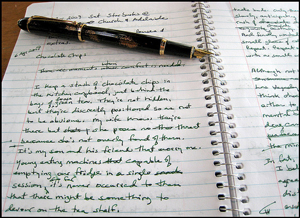
Source: Writing Challenge, Gene Wiburn, Flickr
In previous sections, I compared the writer who is in the process of revision to a chef and a coach. In doing so I used figurative language, creating metaphors that compare seemingly unlike people. My purpose was to illustrate what your behaviors have in common with a chef or coach who adds or substitutes “ingredients” or “players” to improve a recipe or alter the outcome of a game. Using these metaphors, I suggested that you can use strategies such as adding or substituting to polish your writing. By following my example and making a conscious effort to craft figurative language during the revision process, you can “spice up” your style and "boost your score” when you write.
Two types of figurative language, the simile and the metaphor, can be especially effective as you refine a draft of a composition. Both compare seemingly unlike things or persons. A simile includes the words like or as. A metaphor creates a connection without those words. Consider these examples.

Source: COACH.PNG, Nepotolemus, Wikimedia
Simile: A writer is like a coach.
Metaphor: A writer is a coach.
Soon you will practice creating similes or metaphors of your own. Look at the examples below.
- A writer is like a coach because both make substitutions (of words or players) to improve performance.
- A writer is a chef because both experiment with ingredients (words or foods) to create the tastiest dish or most polished composition.
 In your notes, write similes or metaphors comparing each of the two items to something that seems unlike them. Be sure to explain how the two items are actually alike. Answers will vary greatly, but when you’re finished, check your understanding to make sure you’re on the right track.
In your notes, write similes or metaphors comparing each of the two items to something that seems unlike them. Be sure to explain how the two items are actually alike. Answers will vary greatly, but when you’re finished, check your understanding to make sure you’re on the right track.-
Simile: “The first day of school is like . . .”
-
Metaphor: “Learning a foreign language is . . .”
-
The first day of school is like running a marathon because it is an exhausting test of your physical and mental endurance after a leisurely summer vacation.
-
Learning a foreign language is a maze you must navigate to avoid getting lost in vocabulary and tangled in usage.